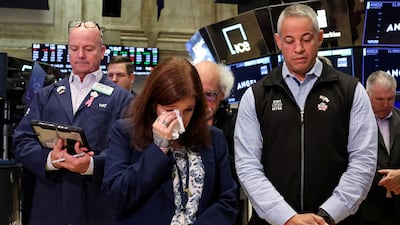Global stock markets mostly gained on Friday, in the lead-up to next week's highly anticipated interest rate decision from the US Federal Reserve that will set the tone for investors.
The US central bank has kept interest rates steady despite months-long pressure from President Donald Trump, who has demanded lower rates and increased his attacks on the Fed, particularly on chairman Jerome Powell.
He has also made the unprecedented move of sacking Fed governor Lisa Cook for what Mr Trump alleges is mortgage fraud. A US judge, however, temporarily blocked the firing this week.
Mr Powell, however, has indicated previously that the Fed is leaving its options open.
In a milestone speech at the Jackson Hole economic policy symposium in August, he suggested that changing economic conditions – namely in the labour market – “may warrant adjusting our policy stance”.
But odds for a Fed rate cut rose after a series of reports on the US economy cast a cloud on the outlook.
Last Friday's weaker-than-expected job creation report underlined concerns over the strength of the US labour market and gave impetus for the Fed to go ahead with the move.
The consumer price index showed that inflation rose to 2.9 per cent in August, the fastest pace since the start of the year. That is up from 2.7 per cent in July and still well above the Fed's 2 per cent target.
Initial readings show US consumer sentiment also fell in September to the lowest level since May, the University of Michigan said on Friday.
The Federal Open Market Committee, which sets interest rates, meets on September 16 and 17. Analysts are pricing in two or three rate cuts in 2025.
“It’s not that the inflation data matters much at this stage – all attention is shifting toward the weakening US jobs market – but yesterday’s CPI figures, broadly in line with expectations, combined with a jump in initial jobless claims, gave full justification to those calling for a Fed cut next week,” said Ipek Ozkardeskaya, a senior analyst at Swissquote Bank.
“Two more cuts are already fully priced in before year-end. That’s the good news,” she added.
The bad news, however, is that “unless a Fed official hints at the very last minute that rates could be cut by 50 basis points – as happened last September – next week’s move will almost certainly be limited to 25 basis points”, Ms Ozkardeskaya added. She noted that tariff and weather-related price pressures “remain visible”.
On Wall Street, the S&P 500 inched down and settled nearly flat after it set a record high on Thursday. The Dow Jones Industrial Average retreated 0.6 per cent, while the tech-heavy Nasdaq Composite rose 0.4 per cent after its own record also on Thursday.
For the week, the S&P 500 was up 1.6 per cent, the Dow added 1 per cent and the Nasdaq increased 2 per cent. Year-to-date, the indices are up 11.9 per cent, 7.7 per cent and 14.6 per cent, respectively.
In Europe, London's FTSE 100 closed 0.2 per cent down after paring gains, dragged by lower healthcare and consumer stocks.
Paris's CAC 40 and Frankfurt's DAX were both flat at the end of the trading session.
Earlier in Asia, stocks surged in anticipation of the Fed's interest rate cut next week.
Chinese stocks, in particular, were the most active. The Shanghai Composite hit its highest level since 2015 before settling 0.1 per cent lower, while Hong Kong's Hang Seng Index jumped 1.2 per cent to a four-year peak, led by artificial intelligence companies.
Japan's Nikkei 225 added 0.9 per cent, also on rate cut optimism.
In commodities, oil prices swung to gains and posted a weekly increase after a Ukraine drone attack in Russia that disrupted crude operations there and offset concerns of oversupply in the market.
Brent settled 0.93 per cent higher at $66.99 a barrel, while West Texas Intermediate rose 0.51 per cent to $62.69 per barrel. Both benchmarks leapt more than 2 per cent at one point.
Gold, meanwhile, climbed as investors looked forward to next week's Fed meeting.
The precious metal, traditionally considered to be a hedge against inflation, added 0.23 per cent to $3,643.10 per ounce, after hovering near its record highs earlier in the week.


